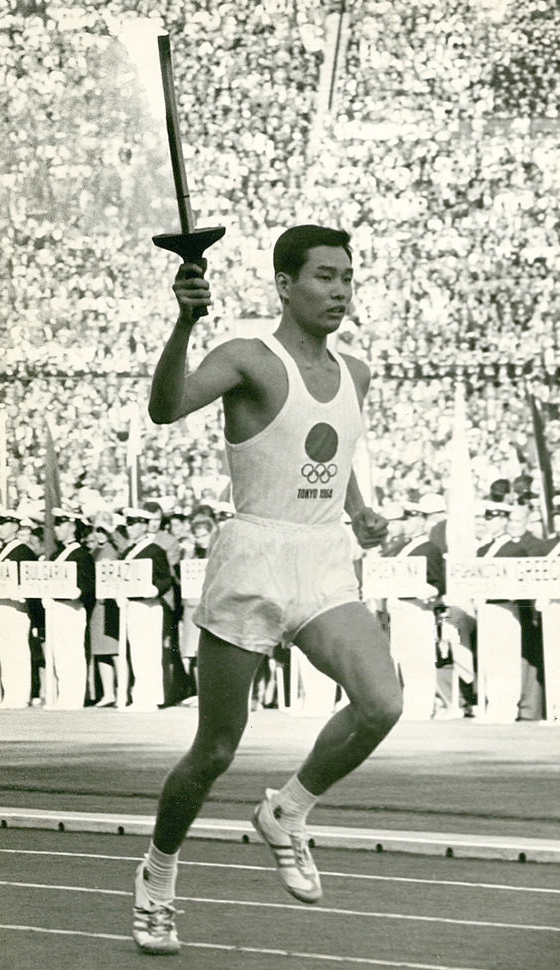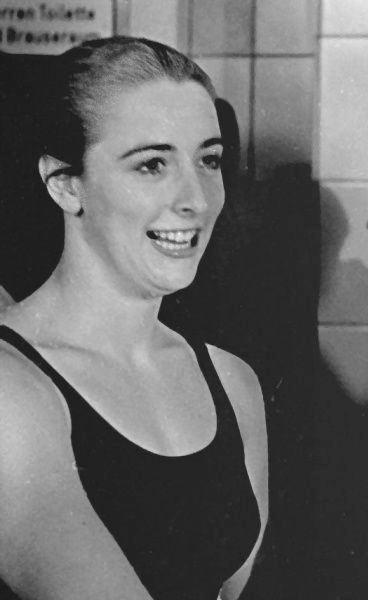Some of you might be wondering why the title of today’s post refers to two cities and two years but only one Olympiad. The answer is that when Tokyo hosted the Summer Games in 1964, it was the Eighteenth Summer Olympiad (though only the fifteenth to have competition due to cancellations in 1916, 1940, and 1944) and when Nagano hosted the 1998 Winter Games, it was the Eighteenth Winter Olympiad.
Before diving into some of the details, I’ll note that while Tokyo became the first city in Asia to host the Games in 1964, the city had been scheduled to host in 1940 before the IOC rescinded the award after Japan invaded China in 1937. I should also mention that Japan also hosted the Eleventh Winter Games in Sapporo in 1972. However, Sapporo is on the island of Hokkaido and we didn’t visit there during our trip.
In what was an emotional and highly symbolic moment for the Japanese, the runner who lit the Olympic Flame was Yoshinori Sakai
(From Wikimedia Commons – Public domain)
an amateur runner who was born in Hiroshima on 6 August 1945. Sakai died on 10 September 2014.
Bans, boycotts, and Olympic firsts
After the Republic of South Africa refused to meet the IOC ‘s demand that they send a multi-racial team, they banned the country’s participation.
In 1963, Indonesia organized and held the Games of the New Emerging Forces (GANEFO) as a counter to the Olympics. The IOC barred athletes who competed at GANEFO from competing at the Olympics. As a result, China, Indonesia, and North Korea boycotted the Tokyo Games.
Now it’s time to shock some younger readers. Early in 1964, the United States successfully placed Syncon 3, the first geostationary satellite, in orbit. (The photo below is actually Syncon 2.)
(Wikimedia Commons – BY NASA – Public domain)
For all intents and purposes, this allowed the first live international broadcast. Although it only applied to some events, these were also the first Games to have any portion of the broadcast in color but these were available only to local viewers in Japan.
The Japanese people got a gift a week before the start of the Games with the first trip of the Tōkaidō Shinkansen – the “bullet train” between Tokyo and Osaka. It reduced travel time by half between the two cities.
And now for one last pre-competition oddity. On 24 October, the last day of the Games, the British Protectorate of Northern Rhodesia declared its independence. It’s athletes, who had marched in the opening ceremony behind a placard reading Northern Rhodesia, were the only team to march behind a placard in the closing ceremony. That placard read Zambia. It made them the only team ever to enter the games under one national name and leave under another.
Now, about those games
The Tokyo Olympics featured the first women’s team sport. Those of you who think it was basketball weren’t paying attention when you read about the Montreal Games in 1976. Rather, the first women’s team sport was volleyball. Six countries competed and the host Japanese team
(From mainichi.com)
won the gold medal topping the team from the USSR in straight sets.
These Games also marked the debut of judo. The sport was dropped for the 1968 Mexico City Games but returned in 1972 with uninterrupted competition since.
Some of you might remember Don Schollander who became the first Olympic Swimmer to win four gold medals (two individual and two relays) in a single Olympic Games and the first American to accomplish the feat since Jesse Owens in 1936. (Schollander won several Athlete of the Year awards including from the Associated Press where he outdistanced runner-up Johnny Unitas.)
Australian swimmer Dawn Fraser won her third consecutive gold medal in the 100 meter freestyle becoming the first woman to win three consecutive gold medals in a single event. But for some perspective on how our attention to Olympic swimming has changed I’ll ask if the name Sharon Stouder has any familiarity. If not, perhaps a photo will help.
(From Wikimedia Commons BY Kroon – Dutch National Archives)
Still no? Strouder was 15 when she competed in Tokyo where she won an individual gold medal in the 100m butterfly, a silver in the women’s 100m freestyle, and a pair of gold medals in the relays. Three golds and a silver. Not a bad haul for a 15 year old whose name few, if any, of us recall.
Although she lost the All-Around title to Czech Vera Czalaska, Ukranian (then Soviet) gymnast Larisa Latynina won two gold, two silver, and two bronze medals raising her career total to 18 Olympic medals – a record that stood until Michael Phelps surpassed it in London in 2012.
Bob Hayes won gold medals in the 100 meter sprint equaling the world record time of 10.06 seconds and the 4 x 100 relay where he ran the anchor leg in an estimated 8.85 seconds. Hayes went on to play professional football with the Dallas Cowboys and was a member of the 1971 Super Bowl Champions making him the only Olympic gold medalist with a Super Bowl championship.
Also on the track, Abebe Bikila of Ethiopia became the first person to win the Olympic marathon twice but it was at the extreme ends of the 10,000 meter race that provided two of the best moments from these Games. Most Americans who are old enough will certainly remember one and know nothing about the other.
If you’re old enough, I should only need to mention the name Billy Mills to stir your memories. Entering the race, Ron Clarke was the prohibitive favorite. The Australian had set the world record of 28:15.6 some 10 months earlier. As for Mills, the Native American Marine whose Lakota name is Tamakoce Te’Hila, he was born and raised on the Pine Ridge Reservation and, though he’d qualified for the U.S. team, he had never run faster than 29 minutes. Of course, he went on to win the gold medal in one of the great upsets in the history of the Olympic Games. Here’s his story in his own words:
To this day, Mills remains the only U.S. gold medalist at this distance.
At the other extreme is the name Ranatunge Karunananda. His name is unknown to Americans but is not only known but is revered by the Japanese. When all the other competitors had finished the race, Karunananda, running for Sri Lanka (then known as Ceylon) had not one but four laps remaining. Here’s his story:
The XVIII Winter Olympiad Nagano 1998
The Games at Nagano featured a number of newly constructed venues to host a competition that featured 72 National Olympic Committees and 2,176 athletes. Some, such as the M-Wave which was built to host long track speed skating
(Wikimedia Commons BY-Naganojmmmm-Own-work-CC-BY-SA-4.0)
and the Aqua Wing Arena, that was converted from an arena that hosted ice hockey to a swimming facility after the Games,
(Wikimedia Commons BY-Naganojmmmm-Own-work-CC-BY-SA-4.0)
were aesthetically striking.
Curling, snowboarding, and women’s ice hockey made their Olympic debuts at Nagano. The women’s ice hockey gold medal game ended with a 3-1 United States win over Canada setting the stage for a long international rivalry.
The National Hockey League suspended its season for three weeks to allow its players to compete in the Olympics. They suspended this practice in 1988, 1992, 1994, and 2018. It planned to renew the practice for the 2022 winter Olympics in Beijing but withdrew due to concerns over Covid-19.
Fifteen year old Tara Lipinski became the youngest Olympic gold medalist in figure skating history winning the gold over countrywoman Michelle Kwan with a program that featured seven triple jumps. However, one of the standout moments came when Frenchwoman Surya Bonaly included this thrilling
albeit illegal move in her free skate program.
Curiously, a mild earthquake with its epicenter 190 kilometers from Nagano briefly interrupted CBS television’s prime time coverage of the event. The camera cut to the unflappable Jim Nantz in the studio. He briefly mentioned the shaking then returned to the coverage.
Bjørn Dæhlie of Norway won three gold medals in cross country skiing. They were the sixth, seventh, and eighth gold medals of his Olympic career which, combined with his four silver medals, were the most by any winter Olympian until Ole Einar Bjørndalen won two gold medals in the biathlon in 2014 at the Sochi Olympics boosting his career total to 13.
Austria won 11 medals in Alpine skiing. Three of the 11 were gold with two coming courtesy of Hermann Maier – the man affectionately called the “Herminator”.
(Wikimedia Commons BY Christian-Jansky-User (Tschaensky)-CC-BY-SA-2.5
Canadian snowboarder Ross Rebagliati won then lost then won the gold medal in the snowboard giant slalom. Rebagliati won the competition but tested positive for THC metabolites (marijuana) and the IOC executive board voted 3-2 to strip him of his medal. Since marijuana wasn’t officially banned at the time, an appeals court restored his medal on 13 February. The IOC put an official ban in place in April 1998. Saturday Night Live had its take on its February 14th show and his Wikipedia page describes him as “an entrepreneur in the cannabis industry.”






